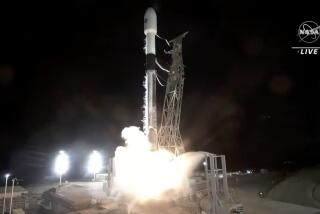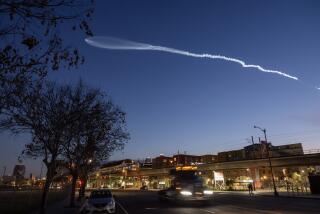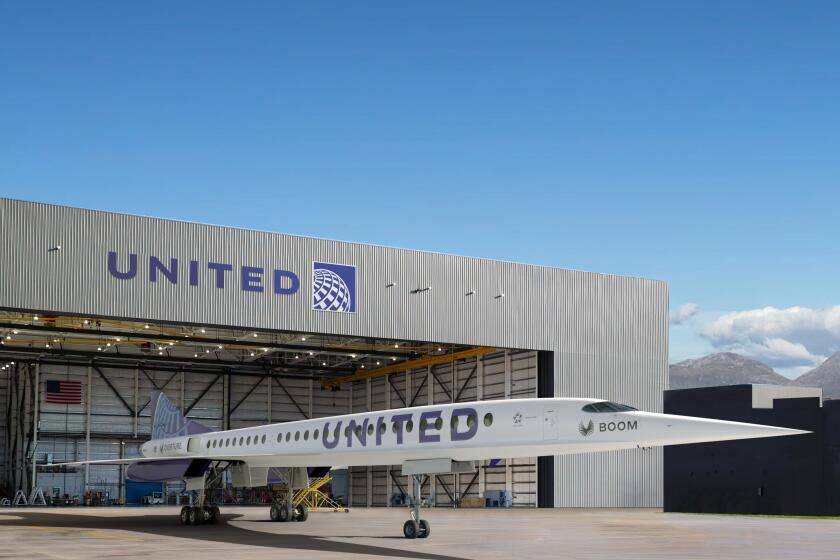Spaceport Seen as Future of Space Travel : White Sands: Visionaries hope to start operating a real commercial facility in the southern New Mexico desert early next century.
- Share via
WHITE SANDS MISSILE RANGE, N.M. — The name--Southwest Regional Spaceport--conjures up images of a futuristic world.
But researchers, businessmen and politicians hope to start operating a real commercial spaceport in the southern New Mexico desert early next century.
They envision a spaceport where rockets for space research, cargo or travel would be launched as regularly as aircraft are flown from today’s airports.
“The concept of the development of a commercial spaceport begins with White Sands (Missile Range) at its heart,” said Gary R. Parker, program director for the project. “But it’s not intended to be just a new mission for White Sands.”
Ideally, the facility would adjoin this Army-run missile range and would share some of the base’s existing infrastructure--such as radar systems and landing strips.
Proponents say the spaceport could be an economic boost not just for New Mexico, but also for Texas, Colorado and Arizona. A spaceport at White Sands, they say, could attract customers and support industries and become the hub of a Southwestern aerospace industry.
The spaceport boosters emphasize that the commercial space launch industry is growing after a period that saw Europe take the lead from the United States.
*
The U.S. space shuttle initially carried all commercial payloads, cutting the demand for conventional, multistage, disposable rockets and prompting the major U.S. aerospace firms to reduce or stop production of such vehicles.
But European countries, dissatisfied with a lag in the shuttle’s schedule, began their own programs for commercial launches.
The 1986 Challenger explosion shut down the shuttle program for more than two years; the government ordered all commercial payloads off the orbiter. The disaster encouraged U.S. firms to resume full production of rockets; by 1989, the American commercial launch industry had taken off.
“Since then, the field has been growing, but the U.S. companies do have less than half of the total international market, in large part because of those 2 1/2 years,” said Chuck Kline, associate director for program affairs with the federal Office of Commercial Space Transportation. That office regulates commercial launches.
Today, there’s a growing interest in developing commercial spaceports. Current efforts are scattered from Florida to Alaska to Hawaii, although Cape Canaveral, Fla., and Vandenberg Air Force Base, Calif., remain the hubs of the nation’s space programs.
The Southwest Regional Spaceport is one of the farthest along, largely because of plans to locate it adjacent to White Sands Missile Range.
The range has conducted commercial launches. It also has the space necessary for spacecraft recovery, a good altitude for launches and facilities to test space equipment.
Several studies are under way to determine infrastructure needs and assess safety issues. New Mexico State University’s Physical Science Laboratory, under Parker’s direction, has largely completed a technical assessment and is working on a business plan for the spaceport.
Parker said interviews are under way to find an executive director for the office of commercial space, which the state Legislature funded this year.
Another step, Parker said, will be to establish a spaceport authority, a policy-making body with the power to issue bonds for development. A spaceport could become fully operational by 2010, he said.
*
The most exciting recent development, in the eyes of spaceport proponents, was the first successful flights of the Delta Clipper-Experimental (DC-X), McDonnell Douglas’ prototype for a single-stage, reusable rocket.
The craft is the cornerstone of the contractor’s attempt to develop a new launch system that eliminates the costly practice of throwing away rocket stages or boosters during takeoff. But it was grounded in October after money for testing ran out. McDonnell Douglas is waiting to find out whether more government funding will be made available.
Aerospace experts say such a vehicle is required if space travel is to become truly affordable and exploitable. Spaceport proponents say, however, they’re determined to move ahead with or without such a system.
More to Read
Inside the business of entertainment
The Wide Shot brings you news, analysis and insights on everything from streaming wars to production — and what it all means for the future.
You may occasionally receive promotional content from the Los Angeles Times.










